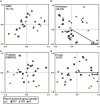Regulation of Soil Microbial Community Structure and Biomass to Mitigate Soil Greenhouse Gas Emission
- PMID: 35547151
- PMCID: PMC9083002
- DOI: 10.3389/fmicb.2022.868862
Regulation of Soil Microbial Community Structure and Biomass to Mitigate Soil Greenhouse Gas Emission
Abstract
Sustainable reduction of fertilization with technology acquisition for improving soil quality and realizing green food production is a major strategic demand for global agricultural production. Introducing legume (LCCs) and/or non-legume cover crops (NLCCs) during the fallow period before planting main crops such as wheat and corn increases surface coverage, retains soil moisture content, and absorbs excess mineral nutrients, thus reducing pollution. In addition, the cover crops (CCs) supplement the soil nutrients upon decomposition and have a green manure effect. Compared to the traditional bare land, the introduction of CCs systems has multiple ecological benefits, such as improving soil structure, promoting nutrient cycling, improving soil fertility and microbial activity, controlling soil erosion, and inhibiting weed growth, pests, and diseases. The residual decomposition process of cultivated crops after being pressed into the soil will directly change the soil carbon (C) and nitrogen (N) cycle and greenhouse gas emissions (GHGs), and thus affect the soil microbial activities. This key ecological process determines the realization of various ecological and environmental benefits of the cultivated system. Understanding the mechanism of these ecological environmental benefits provides a scientific basis for the restoration and promotion of cultivated crops in dry farming areas of the world. These findings provide an important contribution for understanding the mutual interrelationships and the research in this area, as well as increasing the use of CCs in the soil for better soil fertility, GHGs mitigation, and improving soil microbial community structure. This literature review studies the effects of crop biomass and quality on soil GHGs emissions, microbial biomass, and community structure of the crop cultivation system, aiming to clarify crop cultivation in theory.
Keywords: cover crop management practices; cover crops; decomposition; greenhouse gas emission; soil microbial community structure.
Copyright © 2022 Muhammad, Lv, Wang, Ahmad, Farooq, Ali and Zhou.
Conflict of interest statement
The authors declare that the research was conducted in the absence of any commercial or financial relationships that could be construed as a potential conflict of interest.
Figures







Similar articles
-
Organic fertility inputs synergistically increase denitrification-derived nitrous oxide emissions in agroecosystems.Ecol Appl. 2021 Oct;31(7):e02403. doi: 10.1002/eap.2403. Epub 2021 Aug 3. Ecol Appl. 2021. PMID: 34231260
-
Do soil conservation practices exceed their relevance as a countermeasure to greenhouse gases emissions and increase crop productivity in agriculture?Sci Total Environ. 2022 Jan 20;805:150337. doi: 10.1016/j.scitotenv.2021.150337. Epub 2021 Sep 15. Sci Total Environ. 2022. PMID: 34543788
-
Short-term contributions of cover crop surface residue return to soil carbon and nitrogen contents in temperate Australia.Environ Sci Pollut Res Int. 2016 Nov;23(22):23175-23183. doi: 10.1007/s11356-016-7549-5. Epub 2016 Sep 6. Environ Sci Pollut Res Int. 2016. PMID: 27600727
-
Influence of cover crops at the four spheres: A review of ecosystem services, potential barriers, and future directions for North America.Sci Total Environ. 2023 Feb 1;858(Pt 3):159990. doi: 10.1016/j.scitotenv.2022.159990. Epub 2022 Nov 7. Sci Total Environ. 2023. PMID: 36356783 Review.
-
Impact of the mixture verses solo residue management and climatic conditions on soil microbial biomass carbon to nitrogen ratio: a systematic review.Environ Sci Pollut Res Int. 2021 Dec;28(45):64241-64252. doi: 10.1007/s11356-021-15579-7. Epub 2021 Jul 23. Environ Sci Pollut Res Int. 2021. PMID: 34302248
Cited by
-
Straw incorporation and nitrogen fertilization regulate soil quality, enzyme activities and maize crop productivity in dual maize cropping system.BMC Plant Biol. 2024 Jul 30;24(1):729. doi: 10.1186/s12870-024-05451-4. BMC Plant Biol. 2024. PMID: 39080585 Free PMC article.
-
Impact of Agricultural Activities on Climate Change: A Review of Greenhouse Gas Emission Patterns in Field Crop Systems.Plants (Basel). 2024 Aug 17;13(16):2285. doi: 10.3390/plants13162285. Plants (Basel). 2024. PMID: 39204720 Free PMC article. Review.
-
Soil CO2 and N2O emissions and microbial abundances altered by temperature rise and nitrogen addition in active-layer soils of permafrost peatland.Front Microbiol. 2022 Dec 13;13:1093487. doi: 10.3389/fmicb.2022.1093487. eCollection 2022. Front Microbiol. 2022. PMID: 36583043 Free PMC article.
-
Toward Low-Emission Agriculture: Synergistic Contribution of Inorganic Nitrogen and Organic Fertilizers to GHG Emissions and Strategies for Mitigation.Plants (Basel). 2025 May 21;14(10):1551. doi: 10.3390/plants14101551. Plants (Basel). 2025. PMID: 40431118 Free PMC article. Review.
-
Understory species composition mediates soil greenhouse gas fluxes by affecting bacterial community diversity in boreal forests.Front Microbiol. 2023 Jan 20;13:1090169. doi: 10.3389/fmicb.2022.1090169. eCollection 2022. Front Microbiol. 2023. PMID: 36741883 Free PMC article.
References
-
- Abdalla M., Hastings A., Helmy M., Prescher A., Osborne B., Lanigan G., et al. (2014). Assessing the combined use of reduced tillage and cover crops for mitigating greenhouse gas emissions from arable ecosystem. Geoderma 223–225 9–20.
-
- Abdalla M., Rueangritsarakul K., Jones M., Osborne B., Helmy M., Roth B., et al. (2012). How effective is reduced tillage-cover crop management in reducing N2O fluxes from arable crop soils? Water Air Soil Pollut. 223 5155–5174. 10.1007/s11270-012-1268-4 - DOI
-
- Ackroyd V. J., Cavigelli M. A., Spargo J. T., Davis B., Garst G., Mirsky S. B. (2019). Legume cover crops reduce poultry litter application requirements in organic systems. Agron. J. 111 2361–2369. 10.2134/agronj2018.09.0622 - DOI
Publication types
LinkOut - more resources
Full Text Sources

